engine oil AUDI Q3 2016 Owners Manual
[x] Cancel search | Manufacturer: AUDI, Model Year: 2016, Model line: Q3, Model: AUDI Q3 2016Pages: 252, PDF Size: 62.81 MB
Page 5 of 252
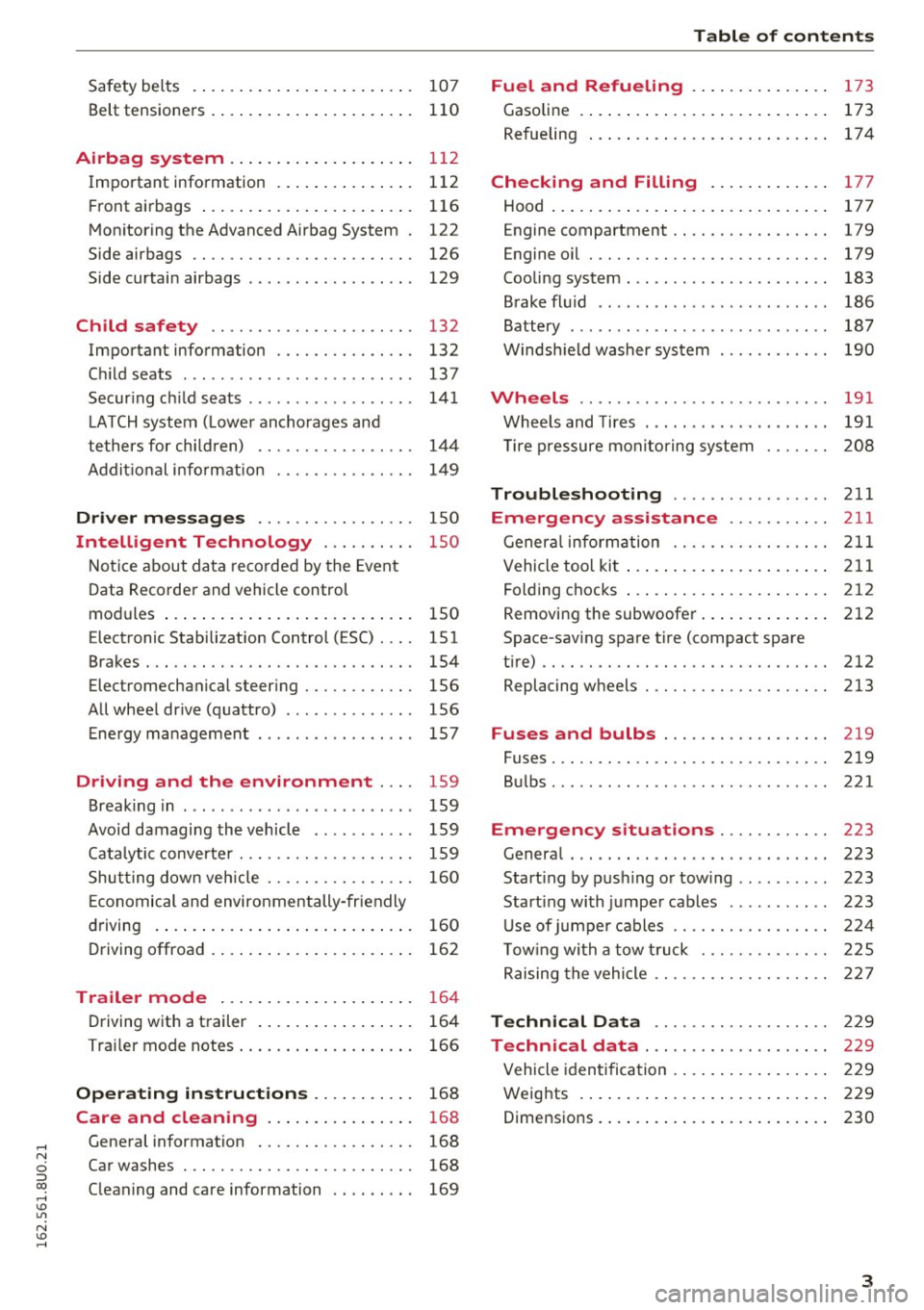
Safety belts . . . . . . . . . . . . . . . . . . . . . . . . 107
Belt tensioners . . . . . . . . . . . . . . . . . . . . . . 110
Airbag system ............... .... . 112
Important information . . . . . . . . . . . . . . . 112
Front airbags ...................... . 116
Monitoring the Advanced Airbag System . 122
Side airbags . . . . . . . . . . . . . . . . . . . . . . . . 126
Side curtain airbags . . . . . . . . . . . . . . . . . . 129
Child safety . . . . . . . . . . . . . . . . . . . . . . 132
Important information . . . . . . . . . . . . . . . 132
Child seats ............... ...... ... . 13 7
Securing child seats . . . . . . . . . . . . . . . . . . 141
LATCH system (Lower anchorages and
tethers for children) . . . . . . . . . . . . . . . . .
144
Addit ional information 149
Driver messages . . . . . . . . . . . . . . . . . 150
Intelligent Technology . . . . . . . . . . 150
Notice about data recorded by the Event
Data Recorder and vehicle control
modul es . . . . . . . . . . . . . . . . . . . . . . . . . . .
150
Electronic Stabilization Control ( ESC) . . . . 151
Brakes . . . . . . . . . . . . . . . . . . . . . . . . . . . . . 154
Electromechanical steering . . . . . . . . . . . . 156
All wheel drive (quattro) . . . . . . . . . . . . . . 156
Energy management . . . . . . . . . . . . . . . . . 157
Driving and the environment . . . . 159
Breaking in . . . . . . . . . . . . . . . . . . . . . . . . . 159
Avoid damaging the vehicle . . . . . . . . . . . 159
Catalytic converter . . . . . . . . . . . . . . . . . . . 159
Shutting down vehicle . . . . . . . . . . . . . . . . 160
Economical and environmentally-friendly
driving . . . . . . . . . . . . . . . . . . . . . . . . . . . .
160
Driving offroad . . . . . . . . . . . . . . . . . . . . . . 162
Trailer mode . . . . . . . . . . . . . . . . . . . . . 164
Driving with a trailer . . . . . . . . . . . . . . . . . 164
Trailer mode notes . . . . . . . . . . . . . . . . . . . 166
Operating instructions . . . . . . . . . . . 168
Care and cleaning . . . . . . . . . . . . . . . . 168
General information . . . . . . . . . . . . . . . . . 168
Car washes . . . . . . . . . . . . . . . . . . . . . . . . . 168
Cleaning and care information . . . . . . . . . 169
Table of contents
Fuel and Refueling . . . . . . . . . . . . . . .
173
Gasoline . . . . . . . . . . . . . . . . . . . . . . . . . . . 173
Refueling . . . . . . . . . . . . . . . . . . . . . . . . . . 17 4
Checking and Filling . . . . . . . . . . . . . 177
Hood . . . . . . . . . . . . . . . . . . . . . . . . . . . . . . 177
E ngine compa rtment . . . . . . . . . . . . . . . . . 179
Engine oil . . . . . . . . . . . . . . . . . . . . . . . . . . 179
Cooling system . . . . . . . . . . . . . . . . . . . . . . 183
Brake fluid . . . . . . . . . . . . . . . . . . . . . . . . . 186
Battery . . . . . . . . . . . . . . . . . . . . . . . . . . . . 187
Windshield washer system 190
Wheels ........ .. ................. 191
Wheels and Tires . . . . . . . . . . . . . . . . . . . . 191
Tire pressure monitoring system 208
Troubleshooting ............. .. .. 211
Emergency assistance . . . . . . . . . . . 211
General information . . . . . . . . . . . . . . . . . 211
Vehicle tool kit . . . . . . . . . . . . . . . . . . . . . . 211
Folding chocks . . . . . . . . . . . . . . . . . . . . . . 212
Removing the subwoofer............. . 212
Space-saving spare tire (compact spare
tire).. .. .. .. .. .. .. .... ... .. .. .. .. ..
212
Replacing wheels . . . . . . . . . . . . . . . . . . . . 213
Fuses and bulbs . . . . . . . . . . . . . . . . . . 219
Fuses. .... .. .. .. .. ....... ........ .. 219
Bulbs . . . . . . . . . . . . . . . . . . . . . . . . . . . . . . 221
Emergency s ituations . . . . . . . . . . . . 223
General . . . . . . . . . . . . . . . . . . . . . . . . . . . . 223
Starting by pushing or towing . . . . . . . . . . 223
Start ing with jumper cables ........... 223
Use of jumper cables . . . . . . . . . . . . . . . . . 224
Towing with a tow truck . . . . . . . . . . . . . . 225
Raising the vehicle . . . . . . . . . . . . . . . . . . . 227
Technical Data . . . . . . . . . . . . . . . . . . . 229
Technical data . . . . . . . . . . . . . . . . . . . . 22 9
Vehicle identification . . . . . . . . . . . . . . . . . 229
Weights . . . . . . . . . . . . . . . . . . . . . . . . . . . 229
D . . 1mens1ons
.. .. . ... ................ . 230
3
Page 13 of 252
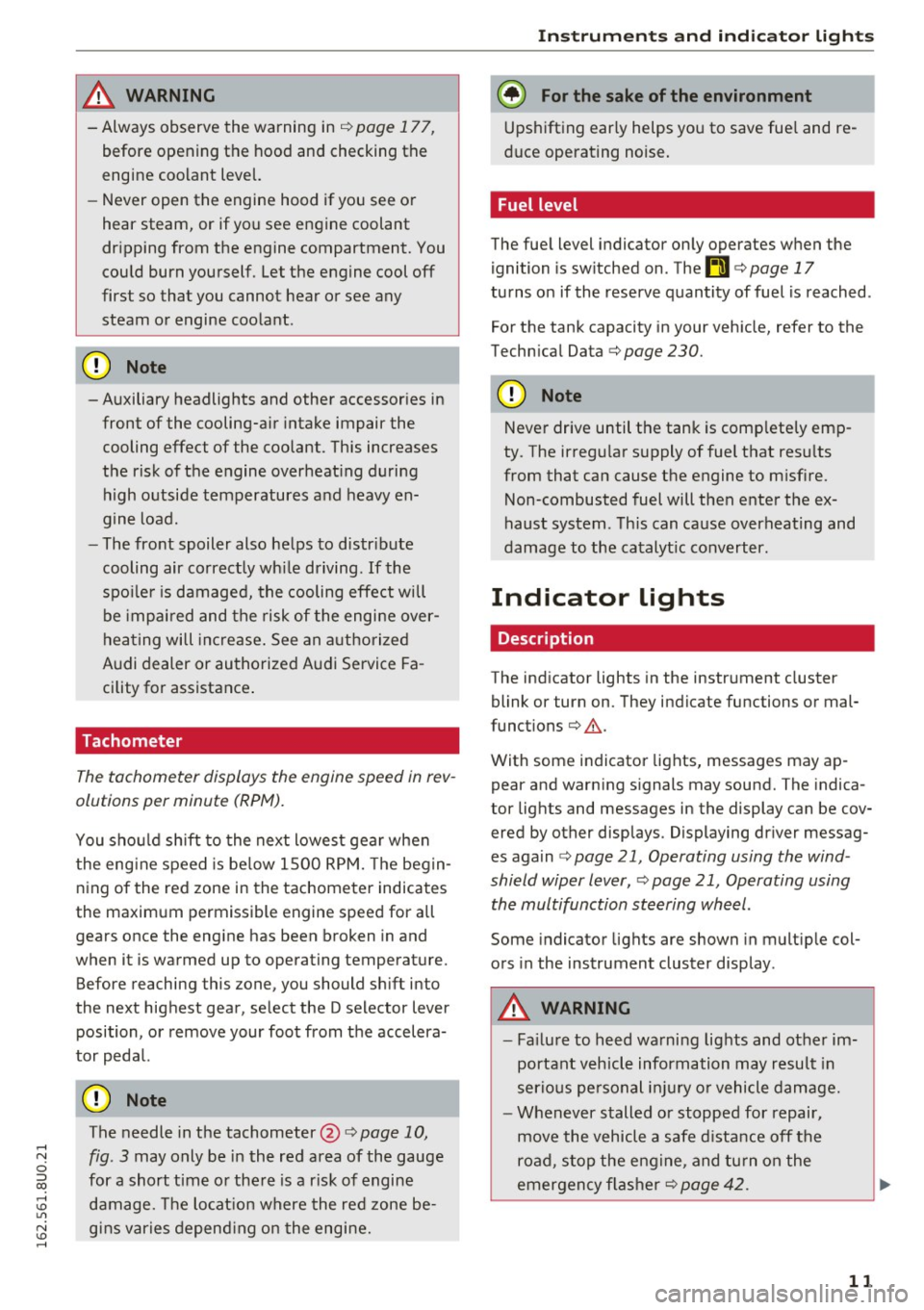
& WARNING
-Always observe the warning in ¢ page 177,
before opening the hood and checking the
engine coolant level.
- Never open the engine hood if you see or
hear steam, or if you see engine coolant
dr ipping from the engine compartment. You
could burn yourself. Let the engine cool off
firstsothatyoucannothearorseeany
steam or engine coolant .
(D Note
-Auxiliary headlights and other accessories in
front of the cooling-air intake impair the
cooling effect of the coolant. This increases
the risk of the engine overheat ing during
high o utside temperatures and heavy en-
gine load.
- The front spoiler also helps to distr ibute
cooling air correctly wh ile driving .
If the
spo ile r i s damaged, the cooling effect will
be impaired and the risk of the engine over
heating will increase . See an a uthorized
Audi dealer or authorized Audi Service Fa
cility for assistance .
Tachometer
The tachometer displays the engine speed in rev
olutions per minute (RPM).
You shou ld sh ift to the next lowest gear when
the eng ine speed is be low 1 500 RPM. The beg in
ning of the red zone in the tachometer indicates
the maximum permissible engine speed for all
gears once the engine has been broken in and
when it is warmed up to operating temperature. Before reaching this zone, you should sh ift into
the next highest gear , select the D selector lever
position, or remove your foot from the accelera
tor pedal.
CT) Note
The needle in the tachometer@¢ page 10,
fig . 3
may only be in the red area of the gauge
for a short time or the re is a r isk of engine
damage. The locat ion where the red zone be
gins varies depend ing on the engine.
In strum ents an d ind ic a to r ligh ts
{® For the sa ke of the en vironment
Upshifting ear ly helps you to save fue l and re
duce operating noise.
Fuel level
The fue l level indicator on ly operates when the
ignition is sw itched on . The
rD ¢ page 17
turns on if the reserve quantity of fuel is reached .
For the tank capacity in your veh icle, refer to the
Techn ica l Data ¢
page 230.
(D Note
Never drive until the tank is comp letely emp
ty. The irregu lar supply of fuel that res ults
from that can cause the engine to m isf ire.
Non-combusted fuel will then enter the ex
haust system . This can cause overheat ing and
damage to the catalyt ic converter.
Indicator lights
Description
The indicator lights in the instrument cluster
blink or turn on. They indicate functions or mal
funct ions¢ .&..
With some indicator lights, messages may ap pear and warning signals may sound. The indica
tor lights and messages in the display can be cov ered by other displays . Displaying driver messag
es again ¢
page 21, Operating using the wind
shield wiper Lever,
¢ page 21, Operating using
the multifunction steering wheel.
Some indicator lights are shown in multip le col
ors in the instrument cluster display.
& WARNING
--
- Fa ilure to heed wa rning lights and other im
portant vehicle information may resu lt in
serio us pe rsonal inj ur y o r vehicle damage.
- Whenever stalled or stopped for repair,
move the vehicle a safe d ista nce off the
road, stop the engine, and tu rn on the
emergency fl ashe r ¢
page 42 .
11
Page 14 of 252
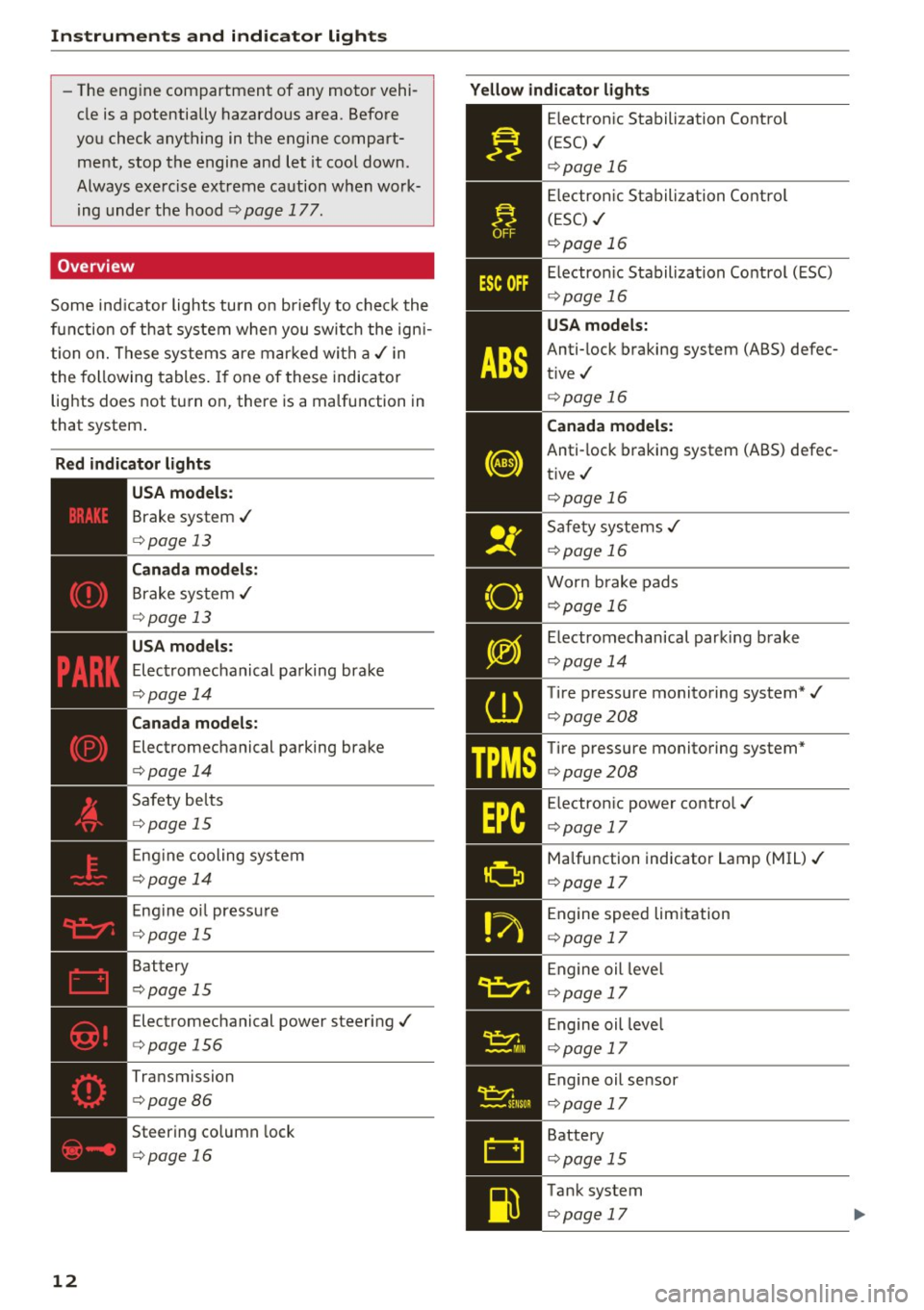
Instruments and indicator lights
-The engine compartment of any motor vehi
cle is a potentially hazardous area. Before
you check anything in the engine compart ment, stop the engine and let it cool down.
Always exercise extreme caution when work ing under the hood¢
page 177.
Overview
Some ind icator lights turn o n briefly to chec k the
f u nction of that syste m whe n you switch the ign i
t ion on. These systems are mar ked with a ./ in
the following tables . If one of these indicator
lights does not turn on, there is a ma lfunction in
that system .
Red indic ator lights
12
USA models:
Brake system ./
¢page 13
Canada mode ls :
Brake system ./
r=.> page 13
USA models :
Electromechanical pa rking brake
r=.> page 14
Can ada mode ls:
Electromechanical parking brake
r=.> page 14
Safety be lts
<=.> page 15
Eng ine cooling system
r=.> page 14
E ng ine o il pressu re
<=.> page 15
Battery
¢page 15
Electromechanical power steering./
<=.>page 156
Transmission
r=.>page86
Steering co lumn lock
<=.> page 16
Yellow indicator l ights
!f
"O~ I I ~ '#
'!IIJ
E lectron ic Stabilization Contro l
(ESC) ./
<=.>page 16
Electron ic Stabiliza tion Cont ro l
( E SC) ./
<=.>page 16
Electron ic Stabiliza tion Control (ESC)
<=.> page 16
USA model s:
Anti-lock braking system (ABS) defec
tive./
<=.> page 16
Canada model s:
Anti-lock braking system (ABS) defec
tive ./
<=.>page 16
Safety systems./
<=.>page 16
Worn brake pads
<=.>page 16
Electromechanical parking brake
r=.> page 14
Tire pressure monitoring system*./
r=.>page208
Tire pressure monitoring system*
r=.>page208
Electron ic power contro l./
<=.>page 17
Malfunction indicator Lamp (MIL) ./
¢page 17
Engine speed limitation
¢ page 17
Engine oil leve l
¢page 17
Engine oil leve l
¢page 17
Engine oil se nsor
¢ page 17
Blll! Battery
·- r=.>page15
r.111 Tank system
... r=.>page17
Page 17 of 252
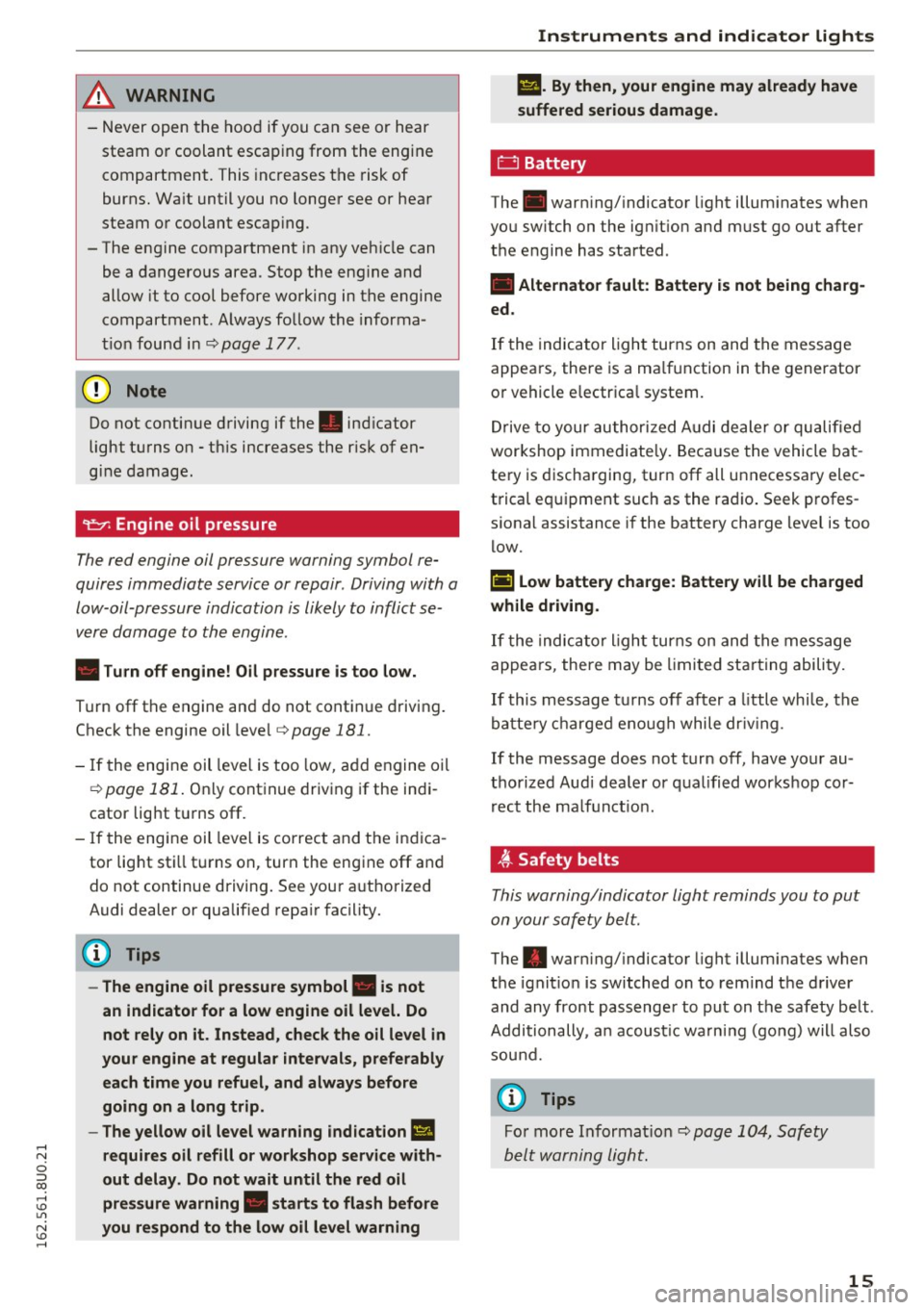
& WARNING
-Never open the hood if you can see or he ar
steam or coolant escaping from the engine
compartment. This inc reases t he risk of
burns . Wa it until you no longe r see or hea r
steam o r coolant escap ing .
- The engine compartment in any veh icle can
be a dangerous area. Stop the eng ine and
allow it to coo l before working in t he engine
compartment . A lways fo llow the informa
ti on foun d in ¢
page 177 .
(D Note
Do not contin ue d riving if the. indicator
light turns o n -thi s increases the r isk of en
gi ne damage.
"t!:r. Engine oil pressure
The red engine oil pressure warning symbol re
quires immediate service or repair . Driving with a
low-oil-pressure indication is likely to inflict se
v e re damage to the engine .
• Turn off engine! Oil pressure is too low.
Tur n off the engine an d do not cont inue d riving .
C hec k the engine oil leve l¢
page 181.
- If the engine oil leve l is too low, a dd engine o il
¢
page 181 . Only cont inue driv ing if the ind i
cator lig ht t urns off.
- If the engine oil leve l is correc t and the i ndica
tor light sti ll tur ns on, turn the eng ine off and
do not continue driving . See you r auth orized
Audi dealer or qualif ied repa ir facility.
@ Tips
-The engine oil pressure symbol. is not
an indicator for a low engine oil level. Do
not rely on it. Instead, check the oil level in
your engine at regular intervals, preferably
each time you refuel, and always before
going on a long trip.
- The yellow oil level warning indication
Ill
requires oil r efill or workshop service with
out delay . Do not wait until the red oil
pressure warning. starts to flash before
you respond to the low oil level warning Instruments and ind
icator lights
IIJ. By then, your engine may already have
suffered serious damage.
0 Battery
The . warn ing/ indicato r light illum inates when
you sw itch on the ig nition and m ust go out after
t h e e ngine has started .
• Alternator fault: Battery is not being charg
ed .
If the indic ator ligh t turns on and the message
appea rs, the re is a ma lfunction in t he generator
o r vehicle e lectr ica l system.
D rive to your au thor ized A udi dealer or qu alified
wor kshop im medi ate ly. Bec au se the vehicle bat
te ry is d ischa rgin g, turn off all u nnecessary elec
t rical eq uipment such as the rad io . Seek p rofes
s iona l assistance if the battery charge level is too
low.
(•) Low battery charge: Battery will be charged
while driving .
If the indic ator ligh t turns on an d the mess age
appea rs, there may be limi ted sta rting abili ty .
If this message turns off after a little whi le, the
ba tte ry ch arge d eno ugh while dr iv ing .
If the message does not turn off, have yo ur au
t h orized Audi de aler or q ual ified works hop cor
r ec t t he ma lf u nct ion.
4t Safety belts
This warning/indicator light reminds you to put
on your safety b elt.
The . war ning/ indicator light illum inates when
t h e ignit io n is switched on to remind t he driver
and any front passenge r to put on the safety be lt.
Addi tionally , a n acous tic w arnin g (go ng) will also
sou nd.
@ Tips
Fo r mor e In forma tion ¢ pag e 104, Saf ety
bel t warning light .
15
Page 19 of 252
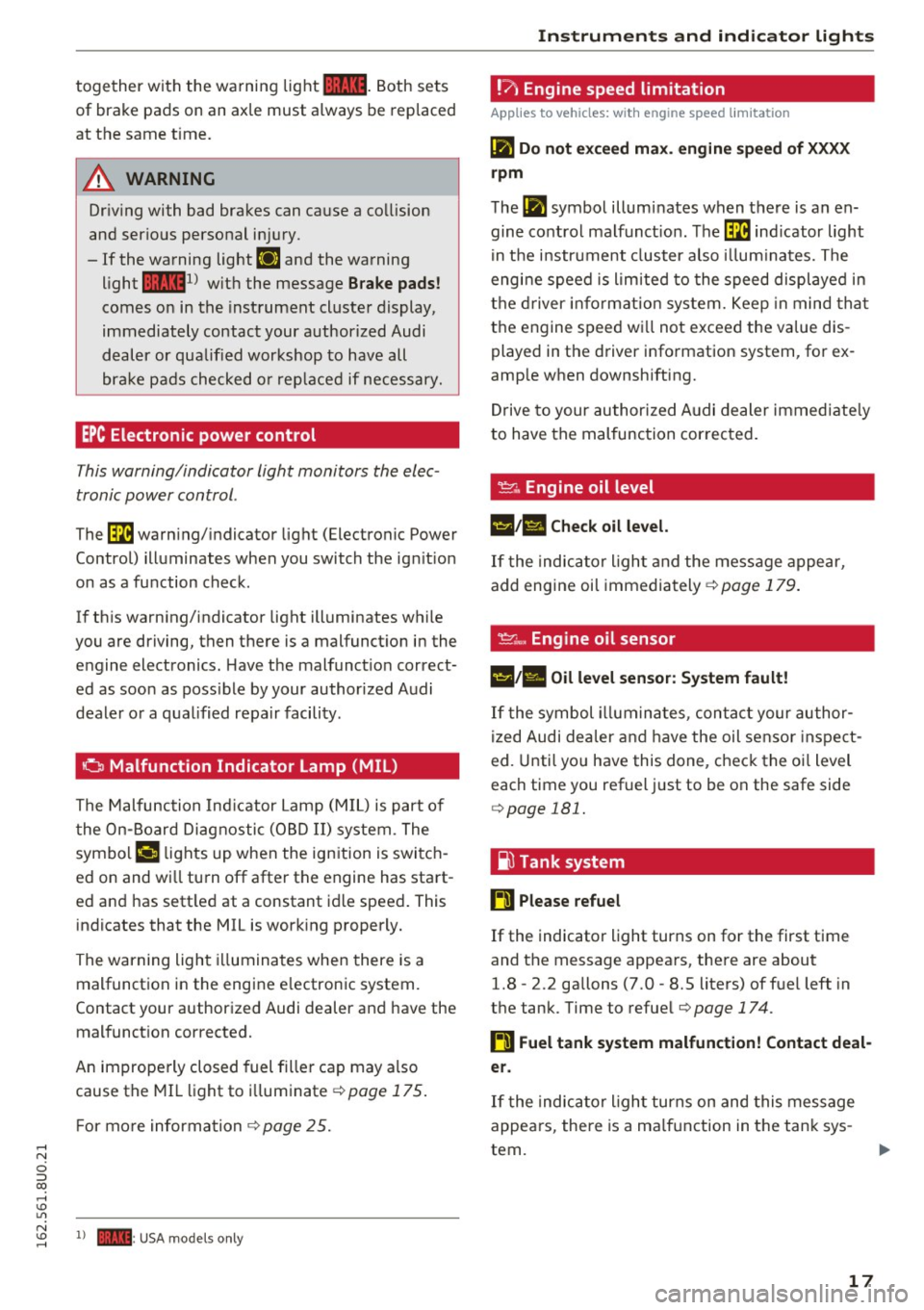
.... N
ci ::, co ....
of brake pads on an axle must a lways be replaced
at the same time.
A WARNING
Dr iv ing with bad brakes can ca use a co llision
and ser ious personal in jury.
- If the warning light
EiJ and the wa rning
light
11111> w it h the message Brake pads!
comes o n in the inst rument cluste r display,
immediately contact your authorized Audi
dealer or qualified workshop to have all
bra ke p ads checke d or rep lace d if necessary.
EPC Electronic power control
This warning/indicator light monitors the elec
tronic power control .
-
The [m warning/ indicator light (Electronic Power
Control) ill uminates when you switch the ig nition
on as a function check.
I f th is wa rn ing/indicator light illuminates w hile
you are driving, then there is a malfunct io n in the
engine electronics . Have t he malfunct io n correct
ed as soo n as poss ible by your authorized A udi
deale r or a qua lified re pair facili ty.
o Malfunction Indicator Lamp (MIL)
The Malfu nction Ind icator Lamp (M IL) i s part of
t he On-Boar d Diag nostic (O BD II) syste m. T he
symbo l¢• lights up when the ign ition is swi tc h
ed on and wi ll tu rn off afte r the engine has sta rt
ed an d has sett le d at a constant idle speed. This
ind icates that the MIL is work ing properly.
The warning ligh t illuminates when there is a
malfunct ion in the eng ine e lectron ic system.
Contact your author ized Audi dealer an d have the
mal funct ion corrected.
An imprope rly closed fuel fille r cap may a lso
cause the MIL li ght to illum inate
c:; page 175 .
For mo re informa tio n ¢ page 25.
N
:=: 1) - : USA mode ls onl y
Instruments and ind icator lights
!'? , Engine speed lim itation
Applies to vehicles: with engine speed limitation
II! Do not exceed max. engine speed of XXXX
rpm
The II! symbol illumi nates when t here is an en
gine co ntro l ma lf u nct io n. Th e
[m indicator light
i n th e i nstr ument clus ter also illumi nates. The
engi ne speed is l imited to the speed displ aye d in
t h e d river informat ion sy stem . K eep in min d that
t h e engine speed w ill not exceed the va lue dis
played in the d river info rmation system, for ex
amp le when downshifting.
Dr ive to your authori zed A udi dea ler imme diate ly
to have t he mal func tion cor rec ted.
~ -Engine oil level
1!1;111 Check oil level.
If the indic ator ligh t an d the message appea r,
add engi ne oil immedi ately
c:; page 17 9.
~e, Engine oil sensor
•• Oil level sensor: System fault!
If the symbol illumi nat es, c onta ct yo ur au th or
ized Audi de aler a nd h ave the oil sensor ins pect
ed. Unti l yo u have this done, check the oi l leve l
each time you ref uel j ust to be on the safe side
c:; page 181.
~ Tank system
ti Please refuel
If the indicato r light turns on for the first time
and t he message appea rs, the re are about
1.8 - 2.2 gallons (7.0 -8.5 liters) of fuel left in
the tan k. Time to refue l
c:;page 174.
ti Fuel tank system malfunction! Contact deal
er.
If t he indic ator ligh t turns on and this message
appea rs, there is a ma lf u nction in the tan k sys
tem .
17
Page 158 of 252
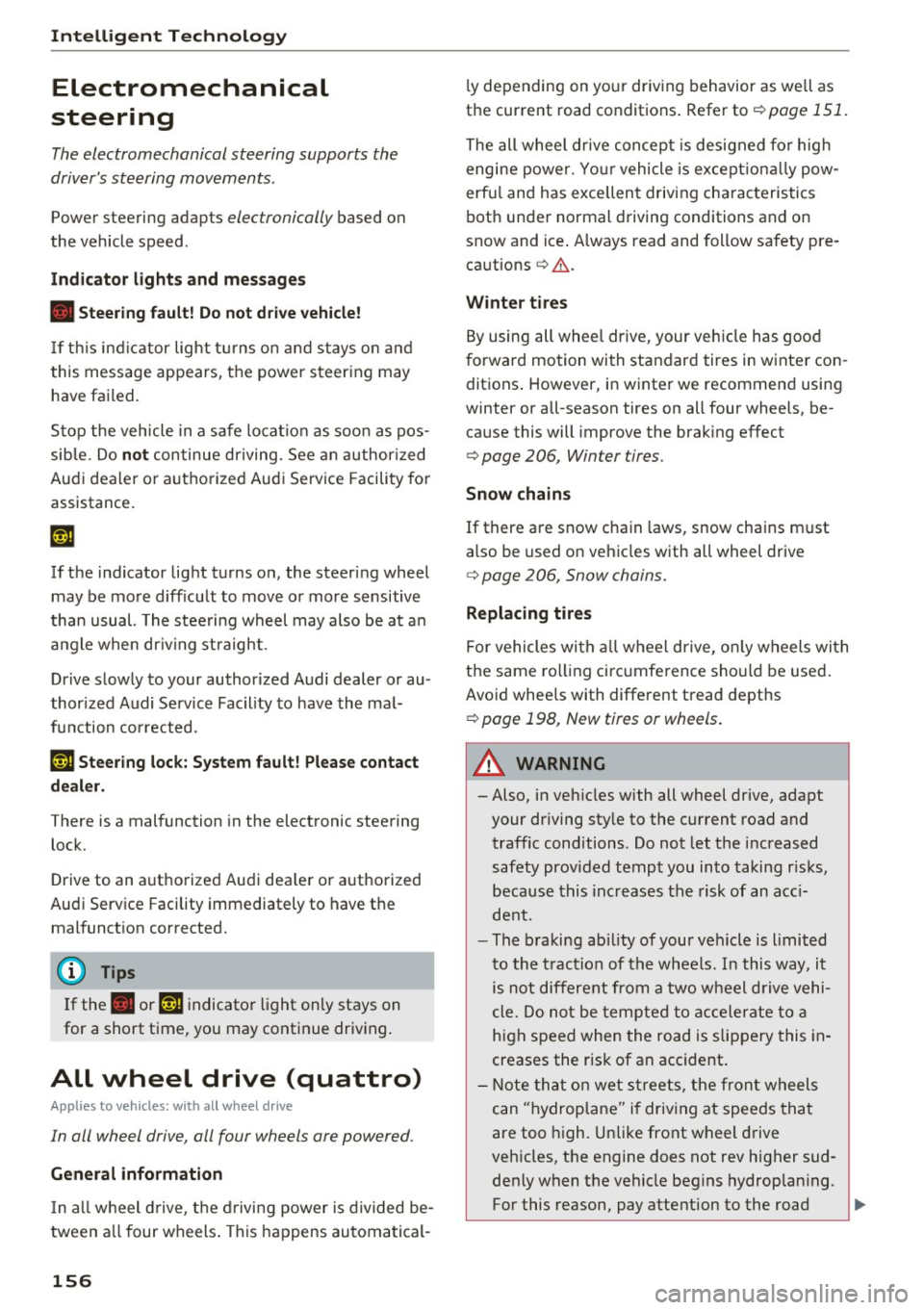
Intelligent Technology
Electromechanical
steering
The electromechanical steering sup ports the
driver's steering movements .
Power steering adapts electronically based on
the vehicle speed .
Indicator lights and mess ages
• Steering fault! Do not drive veh icle!
If thi s ind ic a tor light t urns o n and stays o n and
this message appears, the power steering may
have fa iled.
S top the veh icle in a safe lo cat io n as soo n as pos
sib le. Do
not c on tinue driving. See an author ized
Aud i dea ler o r authorized Aud i Serv ice Facility fo r
assistance.
If the ind icator lig ht t urns on, the steer ing wheel
may be mo re diff icu lt to move o r more sensitive
than usual. The stee ring wheel may also be at a n
angle when dr iving straight .
Dr ive s low ly to your author ized A udi dealer or au
thor ized Audi Se rvice Facility to have the ma l
f u nction co rrected.
E£-ij St eering lock: System fault! Plea se contact
deal er.
There is a malfunction in the electronic steering
lock.
D rive to an a uthorized Audi dea le r or a uthorized
Audi Service Facility immediately to have the
malfunct ion corrected.
@ Tips
If the . or Erj indicato r light on ly stays on
for a short time, you may continue driv ing.
All wheel drive (quattro)
Applies to vehicles: with all wheel drive
In oil wheel drive, oil four wheels ore powered .
General information
In a ll w heel d rive, the d rivi ng power is divided be
tween a ll four wheels . This happens au tomatical-
156
ly depending on yo ur driv ing behavior as we ll as
the cur rent road conditions . Refer to
Q page 151.
The all whee l dr ive concep t is designed fo r high
engine power. Yo ur vehicle is except ion ally pow
erf ul and has excellent drivin g charac teristics
both un der normal driving conditions and on
snow and ice . Always read and follow safety pre
cautions
c:> .&, .
Winter tires
By using all whee l dr ive, your ve hicle has goo d
f orward motion wi th standard tires in w inte r con
ditions . However, in winte r we recommend using
winter or all-season tires on all four wheels, be
cause this will improve the brak ing effect
c:> page 206, Winter tires .
Snow chains
If there are snow chain laws, snow chains m ust
also be used o n veh icles with all wheel drive
c:> page 206, Snow chains.
Replacing tires
Fo r vehicles with all wheel drive, on ly wheels with
t h e same ro lli ng circ umfe rence sho uld be used .
Avoid whee ls with different t read depths
Q page 198 , New tires or wheels .
A WARNING
-Also, in vehicles with all wheel drive, adapt
your driving sty le to the current road and
traffic conditions. Do not let t he increased
safety prov ided tempt you in to taking r isks,
because this inc reases t he risk of an acc i
dent.
- The braking ab ility o f your vehicle is limited
t o th e trac tion of th e wh eels. I n this way, it
is no t differe nt from a two wheel drive vehi
cle. Do no t be tempte d to accelerate to a
hi gh speed when the ro ad is slip pery this in
creases the risk of an accident .
- N ote tha t on wet s tree ts, the front wheels
can " hydrop lane" i f driv ing at spee ds tha t
are too high. Unlike front wheel drive
veh icles, t he engine does not
rev higher sud
de nly when t he vehicle begins hydroplan ing.
For this reason, pay attention to the road
Page 161 of 252
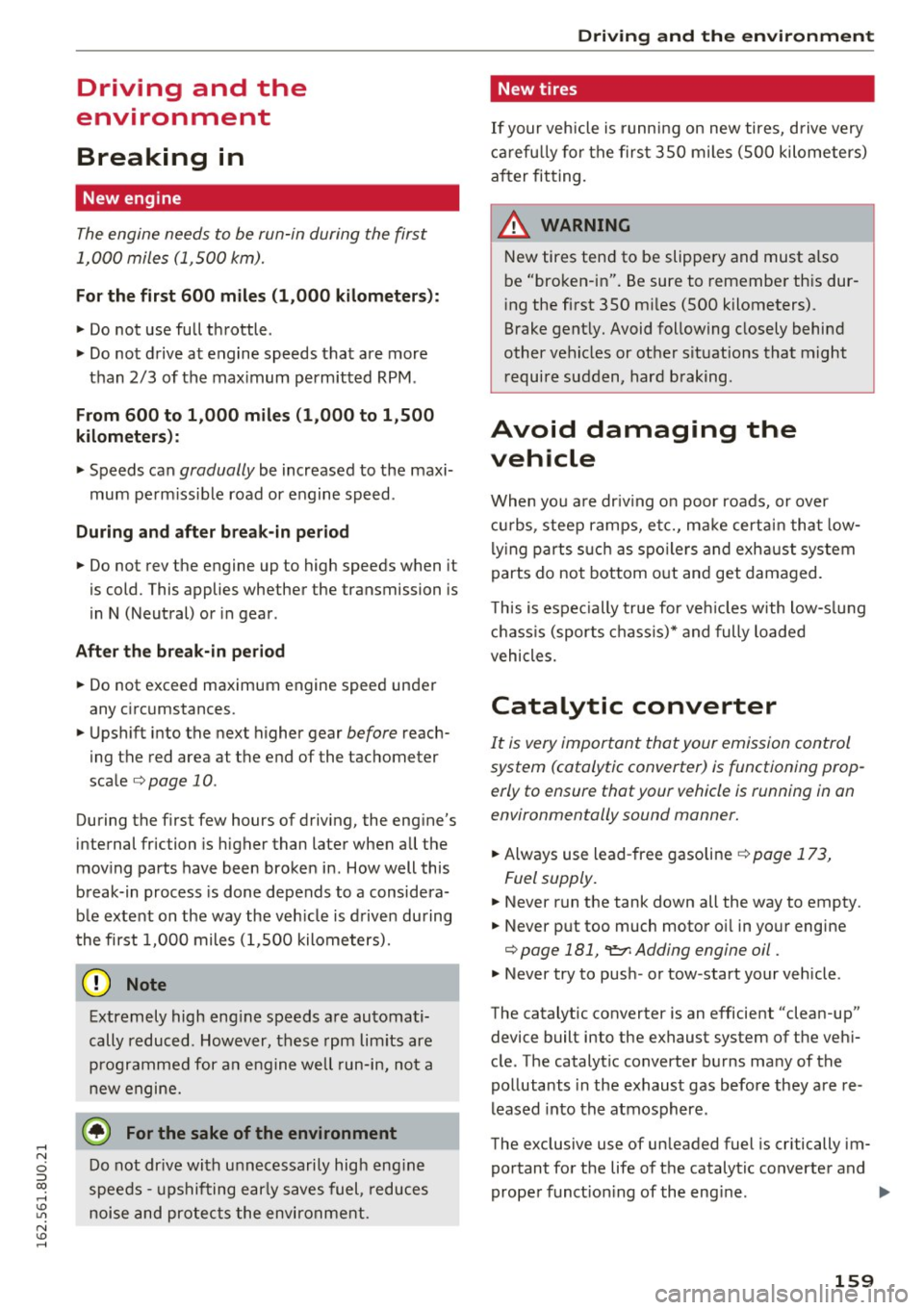
Driving and the
environment
Breaking in
New engine
The engine needs to be run-in during the first
1,000 miles (1, 500 km).
For the first 600 miles (1 ,000 kilometer s):
"' Do not use full throttle .
"' Do not drive at engine speeds that are more
than
2/3 of the max imum permitted RPM .
From 600 to 1,000 miles (1 ,000 to 1 ,500
kilometers):
"' Speeds can gradually be increased to the maxi
mum pe rm issib le road or engine speed .
During and after break-in pe riod
"' Do not rev the engine up to high speeds when it
is cold. This applies whether the transmission is
in N (Neutral) or in gear .
After the break-in period
"'Do not exceed maximum engine speed under
any c ircumstances .
"'U pshift into the nex t higher gear
before reach
ing the red area a t the end of the tachometer
sca le
c=> page 10.
During the first few hours of driving, the eng ine's
internal fric tion is higher than later when all the
mov ing parts have been broken in . How well this
b reak-in process is done depends to a considera
b le exte nt on the way the veh icle is d rive n during
t he first 1,000 miles (1,500 kilometers).
(D Note
Extremely high eng ine speeds a re au toma ti
cally reduced . However, these rpm limits are
programme d for a n engine well run-in, not a
new engine.
@) For the sake of the environment
D o not dr ive with u nnecessari ly high eng in e
spee ds -ups hifting ea rly saves fuel, reduces
noise and pro tec ts the envi ronme nt.
Driving and the envir onment
New tires
If your vehicle is runn ing on new tires, d rive very
car efu lly fo r the firs t 35 0 miles (500 kilometers)
a ft er fit ting.
WARNING
New tires tend to be slippe ry and must a lso
be "bro ken-in". Be sure to remembe r th is dur
i ng the fi rst 350 m iles (500 kilometers).
Brake gent ly. Avoid following closely behind
other vehicles or other s ituations that m ight
r equire sudden, hard b raking .
Avoid damaging the
vehicle
When yo u are dr iv ing o n poor roa ds, or over
cur bs, stee p ramps, e tc., ma ke cert ain that low
ly ing parts s uch a s spo ile rs a nd exh aust sy stem
parts do no t bottom o ut and get dama ged.
T his is espec ially true for ve hicles with low-s lung
c h ass is (sports c hass is) * and fully loaded
vehicles.
Catalytic converter
It is very important that your emission control
system (catalytic converter) is functioning prop
erly to ensure that your vehicle is running in an
environmentally sound manner.
"' Always use lead -free gasoline c> page 173,
Fuel supply.
"' Never run the tank down all the way to empty.
"' Never put too much moto r o il in you r engine
c=> page 181, "t':::r. Adding engine oil .
"'Never try to push -or tow -start your veh icle .
The catalytic converter is an efficient "clean-up" device built into the exhaust system of the veh i
cle. The catalyt ic converter b urns ma ny of the
pollutants in the exhaust gas before they are re
leased into the atmosphere .
The exclusive use of un leaded fuel is critically im
portant for the life of the catalytic converter and
prope r fu nct ion ing of the eng ine. ..,.
159
Page 163 of 252
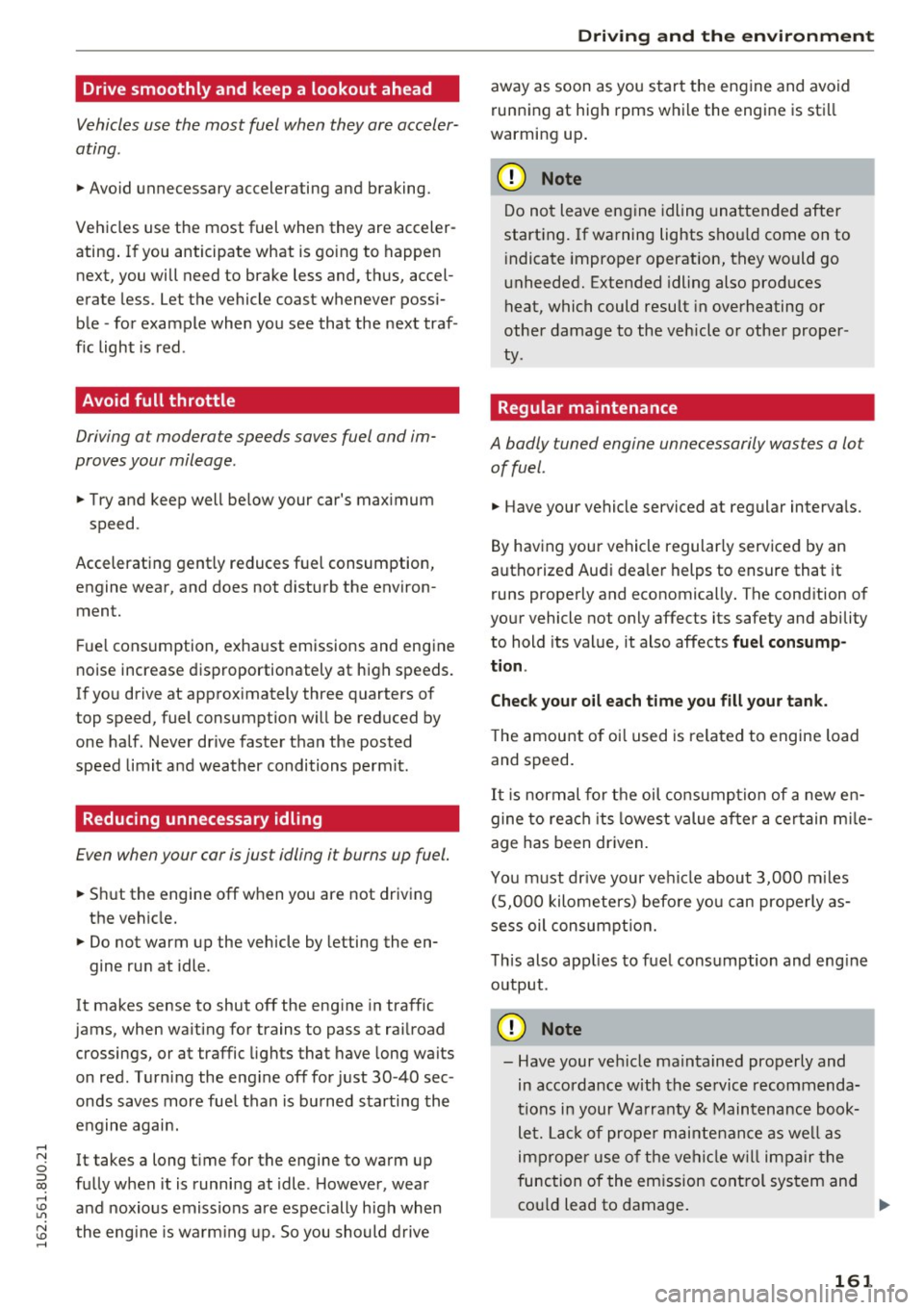
Drive smoothly and keep a lookout ahead
Vehicles use the most fuel when they are acceler
ating .
11-Avoid unnecessary accelerating and braking.
Vehicles use the most fuel when they are acceler ating . If you anticipate what is going to happen
next, you will need to brake less and, thus, accel
erate less . Let the vehicle coast whenever possi
ble - for example when you see that the next traf
f ic light is red .
Avoid full throttle
Driving a t modera te speeds saves fuel and im
proves your mileage .
11-Try and keep well be low your car's max imum
speed.
Accelerating gent ly reduces fuel consumption,
engine wear, and does not disturb the environ
ment.
F ue l cons umption, exha ust emissions and engine
noise increase disproportionately at high speeds.
If you drive at approximately three quarters of
top speed, fuel consumpt ion will be reduced by
one half. Never drive faster than the posted
speed limit and weather conditions permit.
Reducing unnecessary idling
Even when your car is just idling i t burns up fuel.
11-S hut the engine off w hen you are not driving
the vehicle.
11-Do not warm up the vehicle by letting the en-
gine ru n at idle .
It makes sense to shut off the eng ine in traffic
jams, when wa iting for trains to pass at rai lroad
crossings, or at traffic lights that have long waits
on red . Turn ing the eng ine off for just 30 -40 sec
onds saves more fue l than is bu rned starting the
engine agai n.
It takes a long t ime for the engine to warm up
fu lly when it is runni ng at idle . However, wear
and noxious emiss ions are especially high when
the eng ine is wa rm ing up . So you should d rive
Driving and the envir onment
away as soon as you start the eng ine and avoid
running at high rpms w hil e the engine is sti ll
warming up .
(D Note
Do not leave eng ine idling una ttended after
starting. If wa rning lights shou ld come on to
i ndicate improper operation, they would go
unheeded. Extended idling also prod uces
heat, which could result in overheating or
other damage to the vehicle or other proper
ty .
Regular maintenance
A badly tuned engine unnecessarily wastes a lot
of fuel .
11-Have your vehicle serviced at regular interva ls.
By having your vehicle regular ly serv iced by an
authorized Audi dea ler helps to ensure that it
runs properly and economically. The cond ition of
your vehicle not only affects its safety and ability
to hold its value, it also affects
fuel con sump
tion .
Chec k your oil each t ime you fill your tank.
T he amount o f oi l used is related to engine load
and speed.
It is normal fo r the oil consump tion of a new en
gine to reach its lowest value after a ce rtain m ile
age has been dr iven.
You m ust dr ive your ve hicle about 3,000 m iles
(5,000 kilometers) befo re yo u can prope rly as
sess oil consumpt io n.
T h is also app lies to fuel consumption and eng ine
output.
(D Note
- Have your vehicle maintained properly and in accordance with the se rvice recommenda
tions i n your Warranty
& M aintenance book-
le t. La ck of prope r maintenan ce as we ll as
imp roper use of the ve hicle will im pair the
function of the em ission cont rol sys tem and
co uld lead to damage . .,.
161
Page 180 of 252
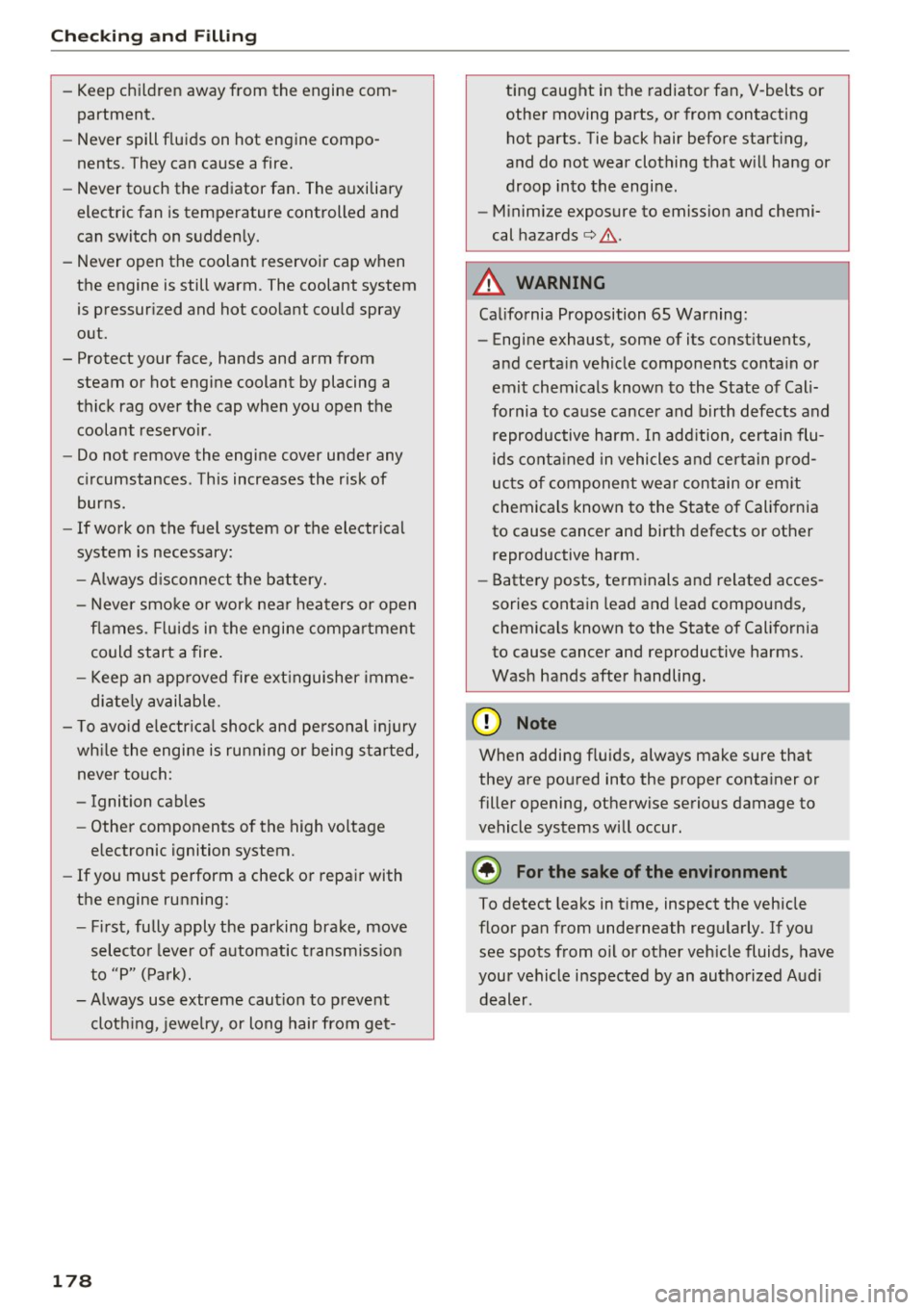
Checking and Filling
-Keep children away from the engine com
partment.
- Never spill fluids on hot engine compo
nents. They can cause a fire.
- Never touch the radiator fan. The auxiliary
electric fan is temperature controlled and
can switch on suddenly.
- Never open the coolant reservoir cap when
the engine is still warm. The coolant system
is pressurized and hot coolant could spray
out.
- Protect your face, hands and arm from steam or hot engine coolant by placing a
thick rag over the cap when you open the
coolant reservoir .
- Do not remove the engine cover under any
circumstances. This increases the risk of
burns .
- If work on the fuel system or the electrical
system is necessary:
-Always disconnect the battery.
- Never smoke or work near heaters or open
flames. Fluids in the engine compartment
could start a fire.
- Keep an approved fire extinguisher imme
diately available.
- To avoid electrical shock and personal injury
while the engine is running or being started,
never touch:
- Ignition cables
- Other components of the high voltage
electronic ignition system.
- If you must perform a check or repair with
the engine running:
- First, fully apply the parking brake, move
selector lever of automatic transmission
to "P" (Park).
- Always use extreme caution to prevent
clothing, jewelry, or long hair from get-
178
ting caught in the radiator fan, V-belts or
other moving parts, or from contacting
hot parts. Tie back hair before starting,
and do not wear clothing that will hang or
droop into the engine.
- Minimize exposure to emission and chemi
cal hazards
c::> & .
A WARNING
California Proposition 65 Warning:
- Engine exhaust, some of its constituents,
and certain vehicle components contain or
emit chemicals known to the State of Cali
fornia to cause cancer and birth defects and
reproductive harm. In addition, certain flu
ids contained in vehicles and certain prod
ucts of component wear contain or emit
chemicals known to the State of California
to cause cancer and birth defects or other
reproductive harm .
- Battery posts, terminals and related acces
sories contain lead and lead compounds,
chemicals known to the State of California
to cause cancer and reproductive harms.
Wash hands after handling.
([) Note
When adding fluids, always make sure that
they are poured into the proper container or
filler opening, otherwise serious damage to
vehicle systems will occur.
@ For the sake of the environment
To detect leaks in time, inspect the vehicle
floor pan from underneath regularly. If you
see spots from oil or other vehicle fluids, have
your vehicle inspected by an authorized Audi dealer .
Page 181 of 252
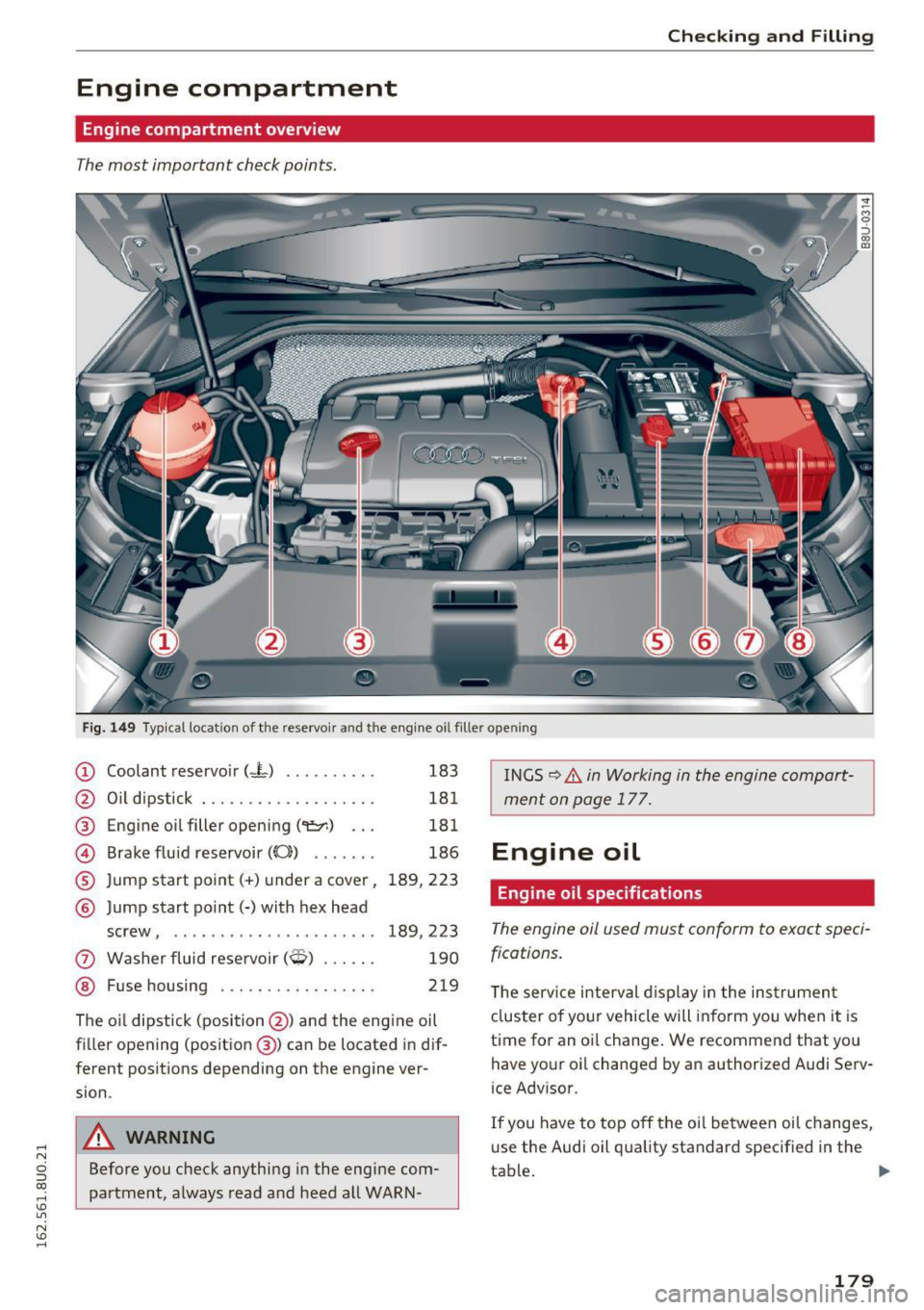
.... N
c:i ::J CX)
.... I.Cl U"I
N I.Cl ......
Checking and Filling
Engine compartment
Engine compartment overview
The most important check points.
Fig. 149 Typical location of the reservoir a nd the engine o il fil ler ope ning
(D Coolant reservoir (-L) . . . . . . . . . . 183
@ Oil dipstick . . . . . . . . . . . . . . . . . . . 181
@ Engine oil filler opening ('1!::r.) . . . 181
@ Brake fluid reservoir (0) . . . . . . . 186
® Jump start point(+) under a cover, 189, 223
® Jump start point(-) with hex head
screw, . . . . . . . . . . . . . . . . . . . . . .
189, 223
0 Washer fluid reservoir($) . . . . . . 190
@ Fuse housing . . . . . . . . . . . . . . . . . 219
The oil dipstick (position @) and the engine oil
filler opening (position @) can be located in dif
ferent positions depending on the engine ver
sion.
A WARNING
Before you check anything in the engine com
partment, always read and heed all WARN- INGS
9 .&. in Working in the engine
compart
ment on page 177.
Engine oil
Engine oil specifications
The engine oil used must conform to exact speci
fications.
T he serv ice interval d isplay in the instrument
cluster of your vehicle will inform you when it is
time for an oil change . We recommend that you
have your oil changed by an authorized Audi Serv
ice Advisor.
If you have to top off the oil between oil changes,
us e the Audi oil quality standard specified in the
tab~ .
~
179